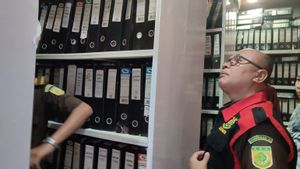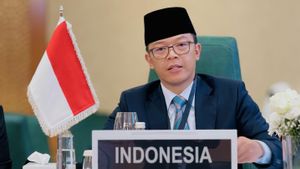JAKARTA - We have to agree that water is a basic human need. The human need for water continues to increase every day, but its availability continues to decrease. Unfortunately, many people don't care about maintaining clean water quality.
Today, March 22, the world commemorates World Water Day or world water day. Quoting the Parangtritis Geomaritime Science Park page, which is part of the Geospatial Information Agency (BIG), the goal of creating a world water day is none other than to make the world community aware of the importance of clean water and sustainable management of water sources.
World water day was first agreed upon in 1992 at the 47th UN General Assembly in Rio De Janeiro, Brazil. A year later, for the first time, this memorial was held around the world. The world community is urged to provide support in water conservation by reducing the use of excessive tap water.
Water is a human need for bathing, washing dishes, washing clothes, until what is most needed, namely for drinking. Even in the human body, 60 to 70 percent contains water content.
Still according to BIG's website, the average human water requirement is 60 liters per person per day. It is estimated that every day the need for clean water will increase from year to year as the human population increases.
Priyono et al in the Journal of Environmental Sciences (2014) noted that 6,121 billion people in the world need 367 km3 of clean water per day. The number of needs is predicted to increase in 2025 as much as 492 km3 per day.
Not everyone can meet their water needs in a healthy manner. Meanwhile, the quantity of water that cannot be used to meet needs continues to increase. Meanwhile, the quality of water for domestic use continues to decline from year to year, according to Priyono (2014).
The world community hopes that Indonesia will take part in commemorating World Water Day. This is because Indonesia is a country that has abundant water resources. Meanwhile, according to data from the Water Environment Partnership in Asia quoted by the BBC, Indonesia is one of the richest countries in water resources because it stores 6 percent of the world's water potential.
About 60 percent of Indonesia's territory is sea water. Although from the majority of water in Indonesia, only 2.5 percent is fresh water. But unfortunately, around 56 percent of the rivers in Indonesia are polluted. With this condition, Indonesia is experiencing a clean water crisis, especially in big cities on the island of Java.

According to a study by the Indonesian Institute of Sciences (LIPI), Java is expected to lose almost all water sources by 2040. According to LIPI Geotechnology Researcher Heru Santoso, the main cause of the water crisis in Java is due to land conversion from infiltration areas to settlements and industrial areas and due to changes. climate.
"Java is still a mainstay industrial area. By 2040 it is predicted that all areas on the North Coast of Java, from Banten to Surabaya, will become urban areas that have the potential to experience a deficit in water availability," Heru quoted the LIPI official website as saying.
Apart from land use change, the clean water crisis also occurs due to climate change. "There is a change in the water cycle which causes more water to evaporate into the air due to increased temperatures due to climate change," explained Heru.
According to Heru, this condition affects the balance of the water balance. The water balance ultimately affects water availability, given that water demand is increasing due to population growth and land changes.
Through a climate projection of Representative Concentration Pathways 4.5, the average annual water deficit in Java will continue to increase until 2070. "Areas experiencing a water deficit are expanding, while wet areas in the western and central parts of Java are decreasing," said Heru. .
Heru explained that what is important for many people to do is to cultivate water savings. The reason is, there are areas that are experiencing drought, but at the same time other areas experience excess water. Therefore this water balance must be balanced.
In addition, another thing that can be done to overcome the water crisis is by empowering marginal water or brackish water. But unfortunately, according to Heru, there is no cheap technology that can be used to meet large needs. Meanwhile, in Middle Eastern countries, sea water can be distilled so that it is clean.
Heru said, the principle of reuse and recycle could be an option to anticipate the potential water crisis in Java. "Take advantage of marginal waters. One of them is water distillation. Maybe the technology is still expensive now, but in the future it can be useful, "he concluded.
The English, Chinese, Japanese, Arabic, and French versions are automatically generated by the AI. So there may still be inaccuracies in translating, please always see Indonesian as our main language. (system supported by DigitalSiber.id)













